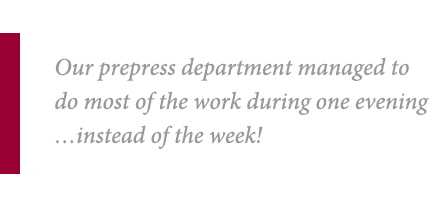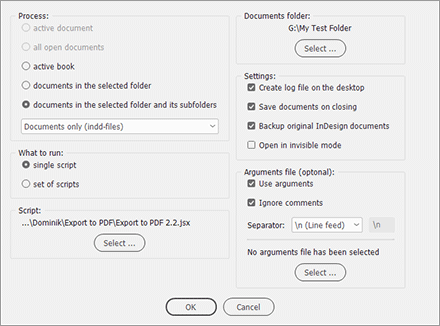Meet Kasyan Servetsky, InDesign Wizard!
August 01, 2023 | Extras | en | fr
At the same time graphic designer, illustrator, prepress expert and scripting guru, Kasyan Servetsky has become one of the most active resource sharers in our microcosm. The InDesign community knows him well (but not enough for my taste!) because of the dozens of great utilities he has created over the past two decades: converters, batch processors, link managers, image resizers, font collectors, and many other gems. Let's step into the lab of this productivity freak…
• Your website is known as a cave of treasures offering tons of tools, links, snippets… But I've the feeling that your own work is not sufficiently visible and commented on. Would you say that “big box stores” won against quality craftsmanship?
 Kasyan Servetsky : Years ago, I started my site just to share a few of my scripts and to familiarize myself with Dreamweaver a little. I didn’t expect it would become so popular. I’d rather say that “big box stores” can coexist with quality craftsmanship: both can find their niches. The internet in general and social networks in particular is the main source of information for me nowadays. I don’t have time to watch TV or listen to the radio. Thanks to social networks and forums I found new clients and friends with the same interests.
Kasyan Servetsky : Years ago, I started my site just to share a few of my scripts and to familiarize myself with Dreamweaver a little. I didn’t expect it would become so popular. I’d rather say that “big box stores” can coexist with quality craftsmanship: both can find their niches. The internet in general and social networks in particular is the main source of information for me nowadays. I don’t have time to watch TV or listen to the radio. Thanks to social networks and forums I found new clients and friends with the same interests.
• Tell me about your professional activity.
K. S. : Currently, I work for Metodika Publishers — a small publishing house specializing in foreign language textbooks — where I am busy mostly with digital printing and preparing layouts: editing and fixing old PDF files provided by foreign publishers and making from them impositions in Kodak Preps.
Right before the Russia-Ukraine war, I found my dream job here in Ukraine: Adobe InDesign Server Automation Engineer. It was supposed that I would start working there at the end of March last year but the project was canceled because of the war.
• Such sad news! The rest of us who observe this drama from so far away can probably not measure its consequences in daily life. How do you get on, concretely?
K. S. : The situation here in Kyiv is much better than it was before the new year: no more regular missile attacks after which we had to live without electricity and water supply for a few days. About a year ago, our company resumed its work so I have regular work and wages. My wife works for an information agency. Our daughter completed the first grade at school and is on summer vacation now. All three of us have to stay mostly at home which makes it quite difficult for me to concentrate on my work. The most difficult situation was last spring — problems with food supply, no public transport working, no work — but now the situation is almost back to normal.
• Looking through your bio I thought you initially worked at the Kiev Polytechnic Institute…
K. S. : I’d like to clarify that I never worked at the Kiev Polytechnic Institute: it’s a high school and I studied there in the Printing department from 1990 to 1995. My specialty was Graphic design and illustration. In those distant times, here in Ukraine, we had no computers so everything was done by hand. Even a small type on a hardcover you have to do by hand with the thinnest — just a few hairs — brush. Another difficult thing to do was make a uniform background for a cover. First, I painted the background on a piece of thick paper with a pulverizer. Then, using tracing paper, I carefully transferred the outlines of my drawings from sketches to the background, and finally, I painted neatly the drawings. It was an elaborate and time-consuming process: the slightest inattention might ruin the whole work.
At that time, they taught us students already outdated technologies like linotype typecasting machines or punched-tape typesetting equipment…
• Wow! You were still light years away from the “digital revolution”, so what brought you into the field?
K. S. : In my last academic year, a small group of our students was invited by a publishing company that was looking for young employees. That’s where we were introduced to state-of-the-art publishing software like Photoshop, Illustrator, and Quark Xpress installed on, at that point, the most modern IBM 486 computers. At that moment I realized that was what I wanted to do in my life.
A few months later I found my first publishing job at the Osvita publishers: a publishing house specializing in the production of textbooks for schools. I had to study both at my new work on workdays and in high school during the evenings and on weekends. After a while, I made enough money to buy my first computer so I was able to learn the things I wanted to know and do some work on the side. By the end of the millennium, I was aware that our publishing house had been stuck in outdated technologies: we still worked in Corel Ventura running on 486 PCs. My bosses — people of preretirement age — didn’t want to learn new things and hated any changes. But I knew that I was capable of so much more so decided to quit.
• Setting out in search of adventure! And that's when InDesign popped up?
K. S. : For a year I was making my living as a freelancer. In 2002, I was offered the vacancy of a prepress specialist in the “Business” Weekly — then the leading economic periodical in Ukraine. I loved this company: they encouraged me to learn new things. In a few months, I offered them to switch from Quark to InDesign and InCopy, and they agreed. I had to solve the technical aspects of the process. There were two major issues: one was the fonts — we used Type 1 fonts — different versions for Mac and Windows. Our designers worked on Macs, but proofreaders and editors on Windows. I had to rework all fonts from scratch making OpenType versions.

Another problem was with InCopy files exported from InDesign. We all worked in shared folders (on a server). InDesign used the beginning of the text for InCopy file names. But the problem was that the text was Cyrillic which ruined the workflow. Desperately looking for a solution, I run across the sample scripts included with InDesign. They were well-commented, plain-text JavaScript files that I could read in TextEdit / Notepad. After some experimenting with them, without any programming knowledge, I was able to make a script that exported InCopy files using the base name plus a randomly generated number which worked perfectly for our workflow. That’s when my scripting career began. I automated all repetitious processes so our prepress department managed to do most of the work during one evening… instead of the week! Then I started writing scripts at the request of other people.
• Now, based on your background in both publishing industry and automation, how do you perceive the evolution of InDesign over the past few years?
K. S. : I have to admit that, in my daily work, I don’t use the new features that appear in every new version. I do mostly small edits in InDesign. In my opinion, the major weakness is the bugs introduced in modern versions. It makes me upset when something that worked, say, back in CS3 no longer works in the current version.
• By the way, have you started programming in IDJS (the new UXP programming model for ID)? How do you rate this technology?
K. S. : I read the Adobe UXP plugins development with React JS book by Davide Barranca. I also played a little with UXP scripts in InDesign and UXP Developer Tool. But so far, I had no time to get down to this seriously: have to do my daily work and bring into shape some of my existing scripts. I am sure the new technology would bring us new possibilities.
I am not going to migrate my existing scripts to UXP format because I don’t have time for this, but I am planning to make new projects as UXP scripts/plugins when the new InDesign version is released.
• I'd love to hear your feelings, or predictions, about how InDesign and the “AI hype” may interact in the future. Are you working on this topic already?
K. S. : As for me, I never used AI to write scripts. One of my customers was in raptures over AI: he showed me how he was able to get from ChatGPT a simple but working script for Illustrator and generate an interesting collage.
I am positive about new technologies. Remember, just a few years ago, Google Translate produced results that we could only laugh at. Now this is a service I use in my everyday life: reading information in any language without the need to spend years to become a polyglot. Of course, AI will never take the place of a professional programmer, as Google Translate will never substitute professional translators, but I am sure in a while, it will come in handy to regular users of Adobe products to automate repetitive tasks.
• Today, can a potential client, say a publishing house or a graphic design agency, contact you to benefit from your skills?
K. S. : As I’ve already mentioned, I am busy now because I have a full-time job. Currently, I work in my home office fixing and preparing layouts for digital printing. In parallel, I am adjusting already existing scripts for my past customers. I’m not able to get down to any new complex projects…
…but I can do simple scripts from time to time.
Interviewed by Marc Autret
• Where to go from now?
→ Kasyan's Personal Website: kasyan.ho.ua/indesign/scripts.html
→ Adobe Community Profile: community.adobe.com
• Related links
→ Metodika (UKR): metodika.ua
→ Kodak Preps: workflowhelp.kodak.com
→ UXP plugins development with React JS: ps-scripting.com
→ UXP Developer Tool: developer.adobe.com

